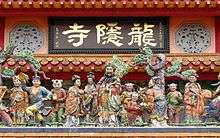Cochin ware
Cochin ware, or Jiaozhi ware (Chinese: 交趾陶; pinyin: Jiāozhǐ táo) is a type of Chinese pottery from Guangdong Province, southern China.

.jpg)
History
Kochin pottery was brought to Taiwan in the 19th century.
The English term "Cochin" derives from the Chinese word Jiāozhǐ (交趾), which was used to describe various parts of the south, including Vietnam (Vietnamese: Giao-chỉ). The region of Cochinchina is an example of the term.
At that time, Cochin ware consisted mainly of decorations for the walls and roof ridges of temples, including human figures, animals, birds, and flowers in bright, glossy colors. Today, there are only a handful of craftspeople who still possess the traditional Cochin skills, most of whom are in the central-island city of Chiayi.
Japan
In Japan it is known as Kōchi ware (Kōchi-yaki). In the old capital city Kyoto the masters of the tea ceremony esteem Kōchi ware as small figures of animals, fish, flowers, dragons, the phoenix etc. Initially imported as shimamono, it became a part of Japanese pottery. The Koshun kiln (洸春窯) is also a production centre in Kyoto.[1]
External links
![]()
- Pottery and Porcelain
- Chiayi City Koji Pottery Museum
- A Handbook of Chinese Ceramics from The Metropolitan Museum of Art